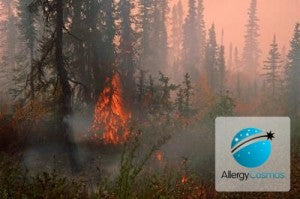Air pollution from landscape fire includes forest, grassland, peatland and agricultural fires. This kind of fire can occur naturally and is on the increase because of global warming. Landscape fire may also be started deliberately because of agricultural practices, clearing tropical rain forest, or arson. Like all forms of combustion – gas cookers, cigarette smoking and car engines, for instance – air pollution from landscape fire consists of a number of pollutants which can be harmful to health. The recent landscape fires in Colorado have drawn attention to these health impacts, which can be particularly serious for people with heart and lung disease (including asthma).
The air pollution from landscape fire contains hundreds of chemicals, many of which are harmful to health. The major components are:
- Carbon dioxide
- Carbon monoxide
- Sulphur dioxide
- Particulate carbon (soot)
Landscape fires emit approximately two petagrams (2 x 1012 kilograms) of carbon every year.
Researchers at the Menzies Research Institute, Tasmania, and elsewhere, have just reported an estimate of the number of premature deaths attributable to air pollution from landscape fire exposure each year, around the world. While there has been extensive research into the health effects of urban air pollution and car exhausts, much less is known of the impact of burning biomass. The researchers used satellite data (to map the landscape fire) and computer modelling, with the known health effects of PM2.5 (Particulate Matter, including carbon of size 2.5 microns or less) to create their estimate. According to the study, there are 339,000 premature deaths each year because of exposure to air pollution from landscape fire. This compares to 800,000 deaths from exposure to urban air pollution and 1.6 million deaths from indoor solid fuel systems, such as wood-burning stoves.
Nearly half of the landscape fire deaths occurred in sub-Saharan Africa and 32% in Southeast Asia, where much of the fire is intentional. There are also landscape fire 'hot spots' in South-East Russia and in Central and South America. Given that natural landscape fire is on the increase because of global warming, the researchers say it is even more important to control intentional burning of the landscape, which means doing more to curtail the destruction of the rain forest and improving agricultural practice around the world.
If you are unlucky enough to be caught in a landscape fire incident, remember that if you can smell smoke and visibility is impaired, then your lungs – and your health – are at risk, as you will be breathing in a toxic cocktail of pollutants. The irritants in air pollution from landscape fire smoke can affect healthy lungs causing coughing, wheezing and nausea. They can aggravate existing asthma and cause asthma in children. The elderly, who are more likely to have heart or lung disease, are particularly at risk of landscape fire smoke, as are young children because their lungs are still developing and do not have full capacity. Medical advice would be to stay indoors, keep the windows closed and purify it with a high-quality air purifier. Exercising out of doors, which causes more air to be inhaled, is also not to be recommended.
Source: Johnston F et al Estimated global mortality attributable to smoke from landscape fires Environmental Health Perspectives (2012); 120: 695-701




